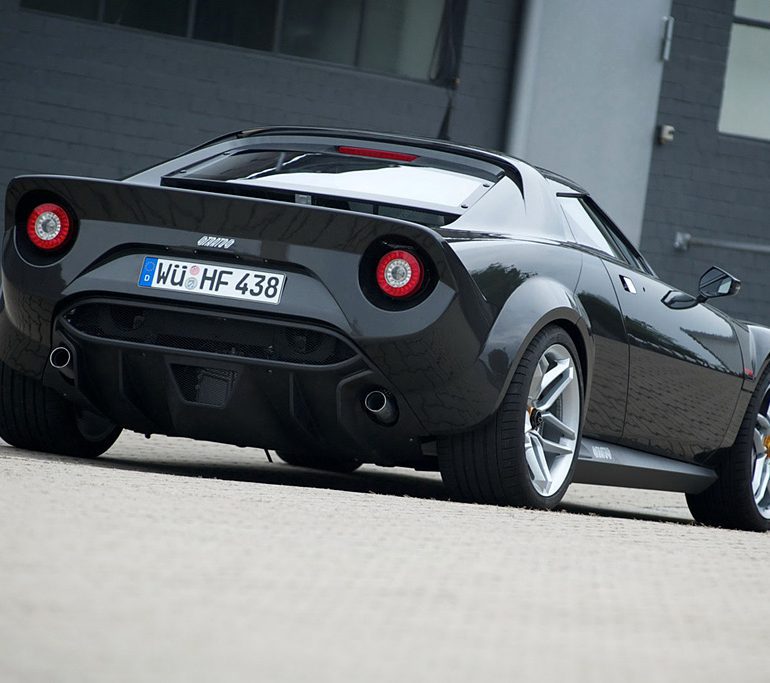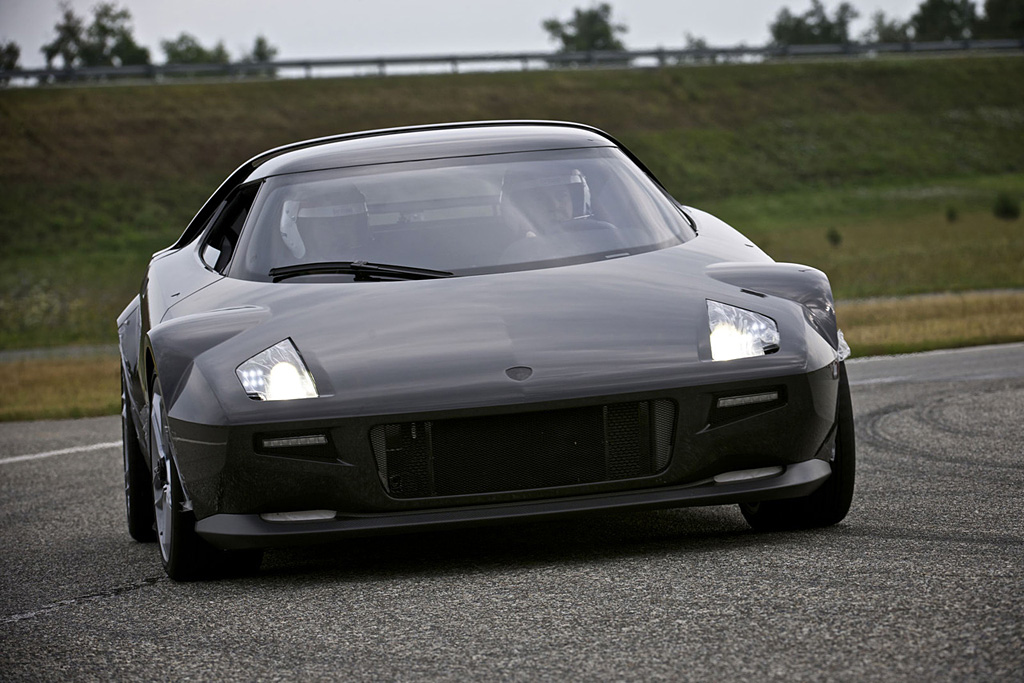2010 Lancia New Stratos
In September 2008, Michael and his son Maximilian Stoschek commissioned Pininfarina to build a one-off vehicle the technical concept and design of which were largely determined by the two car enthusiasts.
The extraordinary success and the fascination of the Lancia Stratos was not only a result of its uncompromising construction for dedicated application in motor sport, but also its unparalleled design. Equally high goals were set for the new Stratos, with the aim to raise the bar amongst current high-performance sports cars in every respect.
As in the original Stratos, a roll cage has been integrated into the body of the sports car, which is mounted on a shortened Ferrari 430 Scuderia chassis. This lends the New Stratos – with its entirely carbon fiber body – greater rigidity, which can in turn be observed in the vehicle’s extremely precise handling. Combined with a weight-to-power ratio of 2.25 kg per HP, and a weight distribution of nearly 50:50, these elements yield exceptional driving performance. The first test drives in Balocco have already lived up to the team’s immense expectations; however, there’s still a lot of work to be done on the details.
Currently, the New Stratos is one of a kind. Whether and by whom an exclusive and licensed production comprising approximately 25 further vehicles will be built, has not yet been decided.
Further details on the New Stratos’ technical specifications will be announced in the coming weeks; in addition, results of the test program currently underway will be documented via extensive photo reportage on these pages.
Design
Creating a modern interpretation of a classic product is an exceptional challenge for a designer. It can be difficult to find the right balance between the issue of, on one hand, drawing too much from the original, and on the other, departing too much from the initial concept. It’s Michael Stoschek’s belief that the more perfect a classic form is, the less it should be changed – the Ford GT 40 offering a good example of this.
Particular caution is necessary when attempting a re-interpretation of a design icon like the Lancia Stratos. The radical Bertone study, with its futuristic design, was itself already well ahead of its time on its presentation in 1970. By holding to the premise “form follows function”, Marcello Gandini smoothly paved the way for further development of the Stratos into a rally legend.
Michael Stoschek found it extremely fascinating to discover that, in addition to Chris Hrabalek, many renowned designers were inspired by the idea of a modern Stratos, and put their time and energies into helping him make his vision a reality.
Stoschek himself specified that, “because the design of the Lancia Stratos was characterized by the contrast between round and rectilinear elements, I wanted to see that tension to be carried over into the New Stratos as well.”
At the end of 2008, work on the New Stratos began at Pininfarina under the designer Jason Castriota, until Castriota moved to Bertone. Over the next year and a half, Luca Borgogno took on the project. It was Borgogno who – in close coordination with Michael Stoschek – brought the design of the New Stratos’ body and interior to completion.
In Detail
| submitted by | admin |
| type | Concept / Prototype Car |
| production | 1 |
| engine | V8 |
| position | Mid, Longitudinal |
| displacement | 4308 cc / 262.89 in³ |
| power | 390.0 kw / 523 bhp @ 8200 rpm |
| specific output | 121.4 bhp per litre |
| bhp/weight | 411.81 bhp per tonne |
| torque | 500.3 nm / 369 ft lbs @ 3750 rpm |
| body / frame | Carbon Fiber Body over Aluminum Chassis w/Steel Roll Cage |
| driven wheels | RWD |
| front tires | 265/30ZR19 Dunlop Sport Maxx |
| rear tires | 315/30ZR19 Dunlop Sport Maxx |
| front brakes | Carbon Ceramic Discs w/6-Piston Calipers |
| rear brakes | Carbon Ceramic Discs w/4-Piston Calipers |
| front wheels | F 48.3 x 22.9 cm / 19 x 9 in |
| rear wheels | R 48.3 x 27.9 cm / 19 x 11 in |
| f suspension | Double Wishbones w/Coil Springs, Dampers |
| r suspension | Double Wishbones w/Coil Springs, Dampers |
| curb weight | 1270 kg / 2800 lbs |
| length | 4181 mm / 164.6 in |
| transmission | 6-Speed Sequential Manual |
| top speed | ~321.80 kph / 200 mph |
| 0 – 60 mph | ~3.5 seconds |







